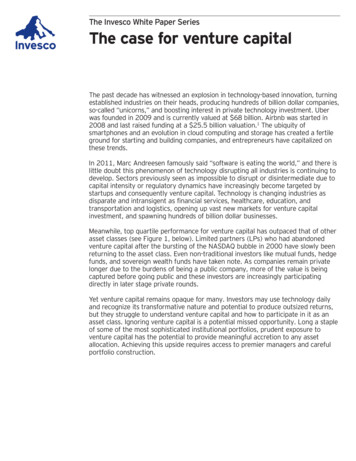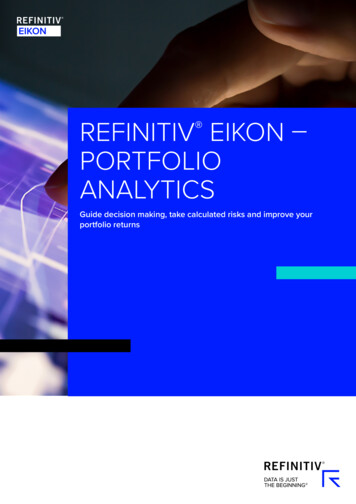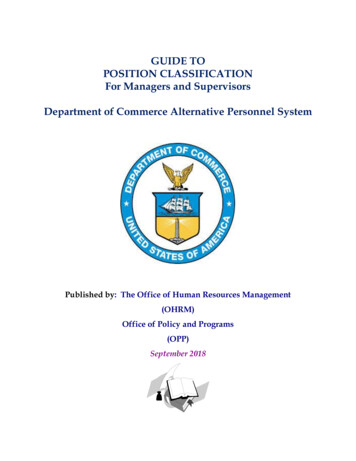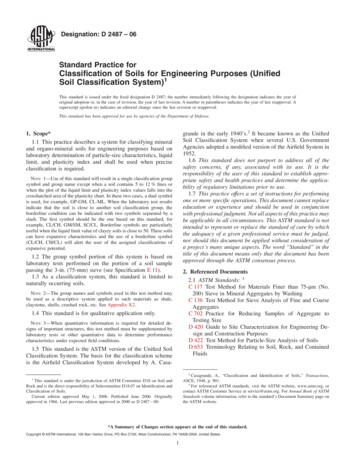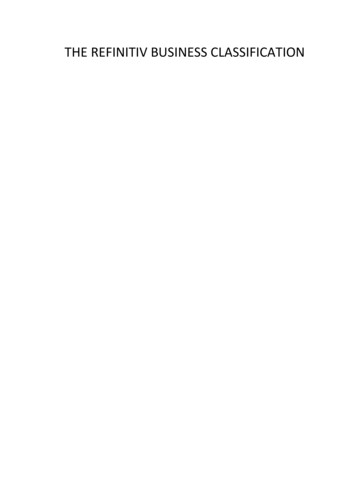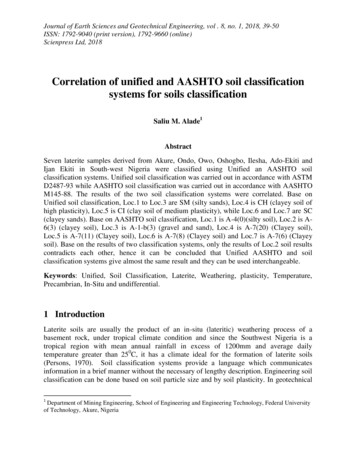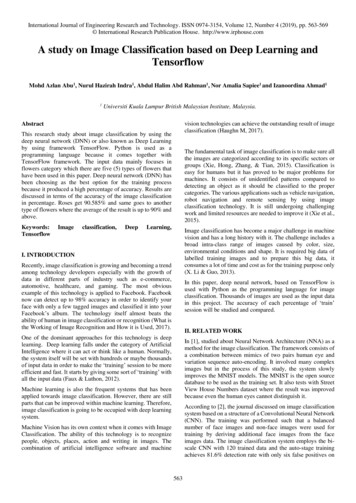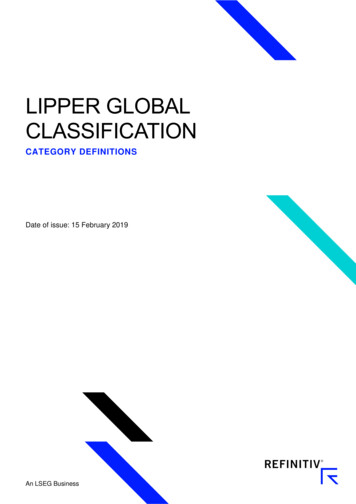
Transcription
LIPPER GLOBALCLASSIFICATIONCATEGORY DEFINITIONSDate of issue: 15 February 2019An LSEG Business
LIPPER GLOBAL CLASSIFICATIONSContentsIntroduction .5Monitoring .5Overview .5Asset Type .6Geographic Focus .6Equity .7Countries & Regions .7Market Cap.8Equity [Region] and [Sm & Mid Cap] .8Equity [Country] and [Sm & Mid Cap] .8Equity Emerging Markets [Region] .8Equity Emerging Markets Other .8Equity Frontier Markets .9Equity [Region/Country] and [Income] .9Equity [Country] Diversified .9Equity Other .9Equity China .9Equity Greater China .9Equity Hong Kong .9Equity Industry Sectors. 10Equity Theme Sectors . 12Equity Theme – Agribusiness. 12Equity Theme – Alternative Energy . 12Equity Theme – Infrastructure . 12Equity Theme – Natural Resources . 12Equity Theme – Water. 12Bond . 13Introduction . 13Aggregate Bond . 13Bond Europe . 13Bond Global (Base Currency) . 14Corporate Bond . 14High Yield Bond . 14Emerging Markets / Asia Pacific Bond .14Bond Emerging Markets Corporates . 14Bond Emerging Markets Other . 14Bond [Currency] Long-Term . 15Bond [Currency] Medium-Term . 15
LIPPER GLOBAL CLASSIFICATIONSBond [Currency] Short-Term . 15Convertible Bond .15Inflation Linked Bond .15Bond (Currency) Government . 16Bond EMU Government . 16Bond EMU Government (Long-Term, Medium-Term, Short-Term) . 16Municipal Bond. 16Bond USD Mortgages . 16Bond Other Inflation-Linked. 16Loan Participation Funds. 16Bond Other . 17Money Market . 18Introduction . 18Money Market [Currency] . 18Real Estate . 19Introduction . 19Real Estate Property [Country/Region] .19Real Estate Property Other . 19Mixed Asset . 20Introduction . 20Base Currencies . 20Risk Degree . 20Country or Region .20Mixed-Asset [Base Currency] Conservative [Country/Region] .20Mixed-Asset [Base Currency] Balanced [Country/Region] . 20Mixed-Asset [Base Currency] Aggressive [Country/Region] .21Mixed-Asset [Base Currency] Flexible [Country/Region] . 21Mixed-Asset Other [Risk Degree] . 21Hedge . 23Introduction . 23Relative Value Strategies . 23Hedge/Convertible Arbitrage . 23Hedge/Equity Market-Neutral . 23Hedge/Fixed Income Arbitrage . 23Hedge/Options Arbitrage/Options Strategies . 24Directional Strategies . 24Hedge/Emerging Markets . 21Hedge/Global Macro . 21Hedge/Long-Bias .21Hedge/Long/Short Equity. 21Hedge/Managed Futures/CTAs . 21
LIPPER GLOBAL CLASSIFICATIONSEvent-Driven Strategies . 22Hedge/Event-Driven . 22Credit Strategies .23Hedge/Credit Focus . 23Mixed and Other Strategies. 23Hedge/Multi-Strategy . 23Hedge/Other Hedge. 23Liquid Alternatives .25Absolute Return . 25Absolute Return [Base Currency] [Value-at-Risk Tertile] . 25Absolute Return Bond (Base Currency) .25Alternative Currency Strategies . 25Alternative Credit-Focus . 25Alternative Dedicated Short Bias . 25Alternative Equity Leveraged . 25Alternative Equity Market-Neutral . 26Alternative Event-Driven. 26Alternative Global Macro . 26Alternative Long/Short Equity [Region] .26Alternative Multi-Strategy . 26Alternative Managed Futures . 26Alternative Relative Value . 27Commodities . 28Commodity Funds – Agriculture . 28Commodity Funds – Industrial Metals .28Commodity Funds – Blended . 28Commodity Funds – Energy . 28Commodity Funds – Precious Metals . 28Commodity Funds – Other . 28Other . 29Guaranteed . 29Protected . 29Target Maturity . 29Unclassified . 29Undisclosed. 29ADDITIONAL NOTES .30Exchange-Traded Funds (ETFs) . 30GLOSSARY. 31Synonyms and Examples . 31
LIPPER GLOBAL CLASSIFICATIONSIntroductionThe purpose of the Refinitiv Lipper Global Classification (LGC) is to create homogeneous groups of funds with comparableinvestment objectives. Funds within one LGC sector invest in the same financial markets or specific segments of thosemarkets but may adopt different investment strategies or styles to achieve their investment objectives. This documentprovides explanations and definitions of the LGC structure. Lipper Global Classifications are to be applied to all funds of thefollowing databases: Mutual Funds Hedge Funds Insurance and Pension Funds Closed-End Funds and Investment Trusts Exchange-Traded Funds (ETFs)LGC sectors are accessible in a variety of methods (Lipper Products, Lipper Feeds, Lipper Media, etc.). With theseclassifications users have the ability to identify and analyse funds in a flexible manner. We operate LGC on a constant reviewbasis. When new fund products or structures enter a fund market, we introduce new classifications as deemed necessary.MonitoringLipper analysts use a variety of processes to monitor fund classifications. Lipper analyses the “outlying” performing funds ineach sector. We also review sectors that fall below the minimum number of 10 unique portfolios. On an annual basis Lippercleans sectors in preparation for the fund awards season running from October to March.OverviewFor each fund in the Lipper global database key classification attributes such as asset type, geographic focus and fundcurrency help us to determine the fund manager’s selection possibilities and classify accordingly.These attributes build a unit of coherent and homogenous information within one fund item. In many cases the LGC sectoralready “holds” information about the asset type and geographical focus: e.g., LGC: Equity France asset type Equity andgeographical focus France. In some cases, a fund may be given a geographical focus that differs from its classification.For example, a fund that has an objective of investing in technology-related stocks and hasa portfolio consistently heavily weighted toward the U.S. will be placed into an Equity Technology sector rather than intoEquity US.As a general rule a fund must hold a prevalent exposure with a threshold set at 75% of its portfolio in order to meet an LGCrequirement. Since temporary changes in strategic asset allocation with divergences from the historical pattern may bepossible, to meet the specific classification requirement it is essential to look at historical data to detect any trend in portfolioallocation. Lipper uses the following sources to assign the LGC: Fund Name Investment Objective (statement of the promoter) Prospectus Fund Factsheet KID / regulated documentsThe primary sources are the investment objective as stated by the promoter and the prospectus. Normally, all sourcesprovide information that leads to the same conclusion.5
LIPPER GLOBAL CLASSIFICATIONSAsset TypeEach fund is assigned an asset type based upon the definitions belowAsset TypeDescriptionEQUITYFunds investing in stock marketsBONDFunds investing in fixed income markets, with an average maturity oneyearCOMMODITYFunds with exposure to commodities, either physically or via derivativesMONEY MARKETFunds investing in fixed income markets, with an average residual lifeto maturity 12 monthsREAL ESTATEFunds investing in physical land property, not REITs or real estate-listedsecuritiesMIXED ASSETFunds with a strategic mix of variable income and fixed income securities.Note that ‘multi-asset’ long only portfolios are also assigned this assettype.ALTERNATIVESFunds investing in alternative assets OR where the source of return arisesfrom a derivative hedge-like strategy. These funds target a stated outcomeand may use traditional asset bases like equity – but only as a means to anend. Other funds will solely use derivative instruments as the source ofreturn e.g. options. By default, all members of hedge fund sectors andalternative sectors will be assigned this asset type. Other funds may alsoqualify: e.g. art, leasing, private equity, and some absolute return fundsOTHERFunds that are unclassified, undisclosedGeographic FocusEach fund is assigned a geographic focus according to the economic exposure of the portfolio. As a general rule a fund mustmaintain at least 50% of its exposure to a specific country/region to be assigned the relevant attribute.6
LIPPER GLOBAL CLASSIFICATIONSEquityFunds strategically invest in variable income securities, with ancillary liquid assets (cash). Funds are classified according totheir local or regional equity exposure. Funds focusing more than 75% on a specific industry are classified in the relevantindustry classification. Funds without a typical and prevalent exposure to a specific industry sector are classified accordingto the geographical stock market exposure. Funds focusing on equities of small- and/or middle-capitalisation companies areclassified in the appropriate small- & mid-cap sector.Countries & RegionsSingle-country funds for which there is no single-country sector are placed in the relevant regional sector that reflects theclosest match. Funds investing in single emerging-market countries are classified in a regional emerging markets sector,unless the relevant country sector is available (e.g., Equity Peru belongs to Emerging Markets Latin America).The following lists all sectors relating to countries and regions.RegionCountryCountryEquity ASEANEquity ArgentinaEquity NetherlandsEquity Asia PacificEquity AustraliaEquity New ZealandEquity Asia Pacific ex JapanEquity AustriaEquity NorwayEquity Australasia1Equity BelgiumEquity PakistanEquity Emerging Mkts EuropeEquity BrazilEquity PhilippinesEquity Emerging Mkts AsiaEquity Philippines IncomeEquity Emerging Mkts GlobalEquity Brazil IncomeEEquity CanadaEquity PolandEquity Emerging Mkts Latin AmEquity Canada IncomeEquity PortugalEquity Emerging Mkts OtherEquity ChileEquity RussiaEquity EuropeEquity ChinaEquity Saudi ArabiaEquity Europe IncomeEquity ColombiaEquity SingaporeEquity Europe ex UKEquity DenmarkEquity South AfricaEquity EurozoneEquity EgyptEquity SpainEquity Frontier MarketsEquity FinlandEquity SwedenEquity GCCEquity FranceEquity SwitzerlandEquity GlobalEquity GermanyEquity TaiwanEquity Global ex JapanEquity GreeceEquity ThailandEquity Global ex UKEquity Hong KongEquity Thailand IncomeEquity Global ex USEquity IndiaEquity TurkeyEquity Global IncomeEquity IndonesiaEquity UAEEquity Greater ChinaEquity IsraelEquity UKEquity IberiaEquity ItalyEquity UK IncomeEquity MENAEquity JapanEquity UK DiversifiedEquity NordicEquity Japan IncomeEquity USEquity OtherEquity KoreaEquity US IncomeEquity KuwaitEquity VietnamEquity MalaysiaEquity Malaysia IncomeEquity Malaysia DiversifiedEquity MexicoEquity Morocco1Australasia is the area that includes Australia, New Zealand, New Guinea, and the many smaller islands in the vicinity,most of which are in the eastern part of Indonesia.7
LIPPER GLOBAL CLASSIFICATIONSMarket CapFor funds that follow a specific small- or mid-cap strategy the LGC has the following sectors available on a country andregional basis. Since the classification is prospectus based, there is no defined limit boundary for the portfolio’s averagemarket capitalisation; rather, a written commitment to follow this strategy is made in the objective or full prospectus.RegionCountryEquity Asia Pacific Sm&Mid CapEquity Australia Sm&Mid CapEquity Australasia Sm&Mid CapEquity Brazil Sm&Mid CapEquity China Sm&Mid CapEquity Canada Sm&Mid CapEquity Emerging Markets Sm&Mid CapEquity France Sm&Mid CapEquity Europe Sm&Mid CapEquity Germany Sm&Mid CapEquity Eurozone Sm&Mid CapEquity Korea Sm&Mid CapEquity Global Sm&Mid CapEquity Italy Sm&Mid CapEquity Global ex US Sm&Mid CapEquity India Sm&Mid CapEquity Nordic Sm&Mid CapEquity Israel Sm&Mid CapEquity Japan Sm&Mid CapEquity Malaysia Sm&Mid CapEquity Poland Sm&Mid CapEquity Sweden Sm&Mid CapEquity Switzerland Sm&Mid CapEquity Taiwan Sm&Mid CapEquity UK Sm&Mid CapEquity US Sm&Mid CapEquity [Region] and [Sm & Mid Cap]Funds with the primary objective of investing in the equity markets of [Region]. Regional small- and mid-cap-focused funds areclassified in the relevant small- and mid-cap sector, if available (see lists above).Equity [Country] and [Sm & Mid Cap]Funds with the primary obje
LIPPER GLOBAL CLASSIFICATIONS 6 Asset Type Each fund is assigned an asset type based upon the definitions below Asset Type Description EQUITY Funds investing in stock .

